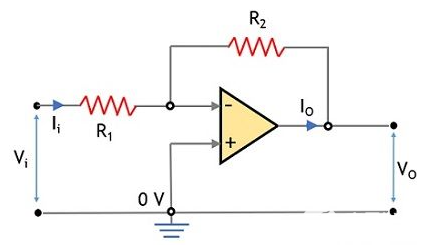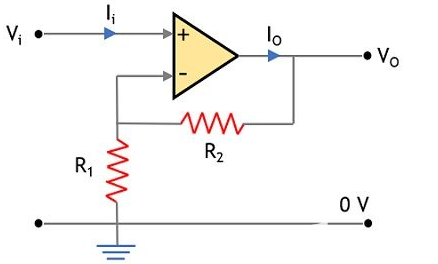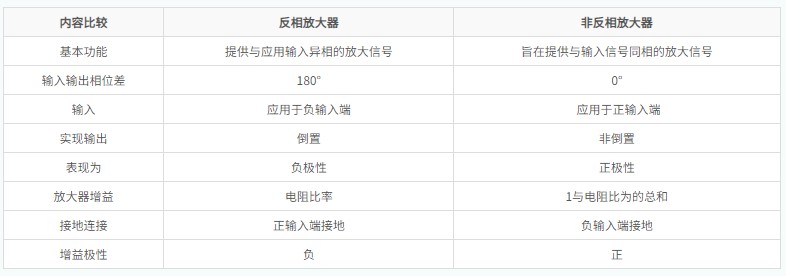The two main classes of operational amplifiers are inverting amplifiers and non-inverting (in-phase) amplifiers. The key difference between an inverting amplifier and a non-inverting amplifier is that an inverting amplifier is an amplifier that produces an amplified output signal that is out of phase with the applied input. In contrast, a non-inverting amplifier amplifies the input signal level without changing the phase of the output signal.
What is an operational amplifier?
Operational amplifiers are considered to be a fundamental component of analogue electronic circuits and are linear devices that are used to amplify DC signals. As such, it is used for signal conditioning, filtering and performing operations such as addition, subtraction and integration. Various components such as resistors and capacitors are present between the input and output terminals of the amplifier and are used to amplify the signals applied at voltage levels.

An operational amplifier is a three-terminal device with two inputs and one output. Of the two inputs, one is inverting while the other is non-inverting. This article gives a brief overview of the differences between inverting and non-inverting amplifiers.
Definition of an inverting amplifier
An operational amplifier designed to generate a signal at the output that is 180° out of phase with the applied input is called an inverting amplifier. This means that if the applied input signal is in positive phase, the amplified signal will be in negative phase. In a similar way, for a signal with a negative phase, the output will be in positive phase.
Inverting amplifiers are considered to be one of the simplest and widely used operational amplifier configurations. The following diagram represents the circuit of an inverting operational amplifier.

As can be seen from the diagram above, feedback is given to the op-amp to make the circuit work in closed loop. In order for the circuit to operate accurately, negative feedback is provided to it. Therefore, in order to have a closed loop circuit, the input is provided at the inverting end of the op-amp as well as the feedback signal from the output.
For the above circuit, the gain is

Definition of a non-inverting amplifier
An amplifier that produces an amplified signal at the output with a phase similar to that of the applied input is called a non-inverting amplifier or in-phase operational amplifier. This simply means that for an input signal with a positive phase, the output will also be positive. The same is true for negative phase inputs.
The following diagram represents the circuit of a non-inverting amplifier.

In this case, the input signal is applied at the non-inverting terminals of the amplifier in order to have an output in the same phase as the input. However, negative feedback is also provided here, so that the feedback signal is supplied to the inverting terminal of the operational amplifier. The closed loop gain of the non-inverting amplifier is shown below.

Note that amplifiers with an inverting configuration can be converted to in-phase amplifiers by simply changing the input connections provided.
A simple comparison of inverting and non-inverting amplifiers and their main characteristics can be found in the following table.

Main differences
The differences between inverting and non-inverting amplifiers can be easily understood from the above comparison, and are mainly manifested in the following aspects.
The key factor in distinguishing between an inverting amplifier and a non-inverting amplifier is done according to the phase relationship that exists between the input and the output. In the case of an inverting amplifier, the output is out of phase with the input. In the case of a non-inverting amplifier, on the other hand, both the input and the output are in the same phase.
The input signal in an inverting amplifier is applied to the negative side of the operational amplifier. In contrast, in the case of a non-inverting amplifier, the input is provided at the positive terminal.
The gain provided by an inverting amplifier is a ratio of the resistors. In contrast, the gain of a non-inverting amplifier is the sum of the ratio of 1 to the resistor.
In an inverting amplifier, the in-phase terminal is grounded. In a non-inverting amplifier, on the other hand, the inverting end of the operational amplifier is grounded.
The inverting amplifier achieves a negative gain, so it provides an inverted output. However, with a non-inverting amplifier, the gain is positive, so the output achieved is essentially non-inverting.
Summing up
This is a brief introduction to inverting and in-phase amplifiers and the main differences between the two. It is important to note that negative feedback is used in both inverting and in-phase amplifiers to help provide controlled gain in the amplifier.
